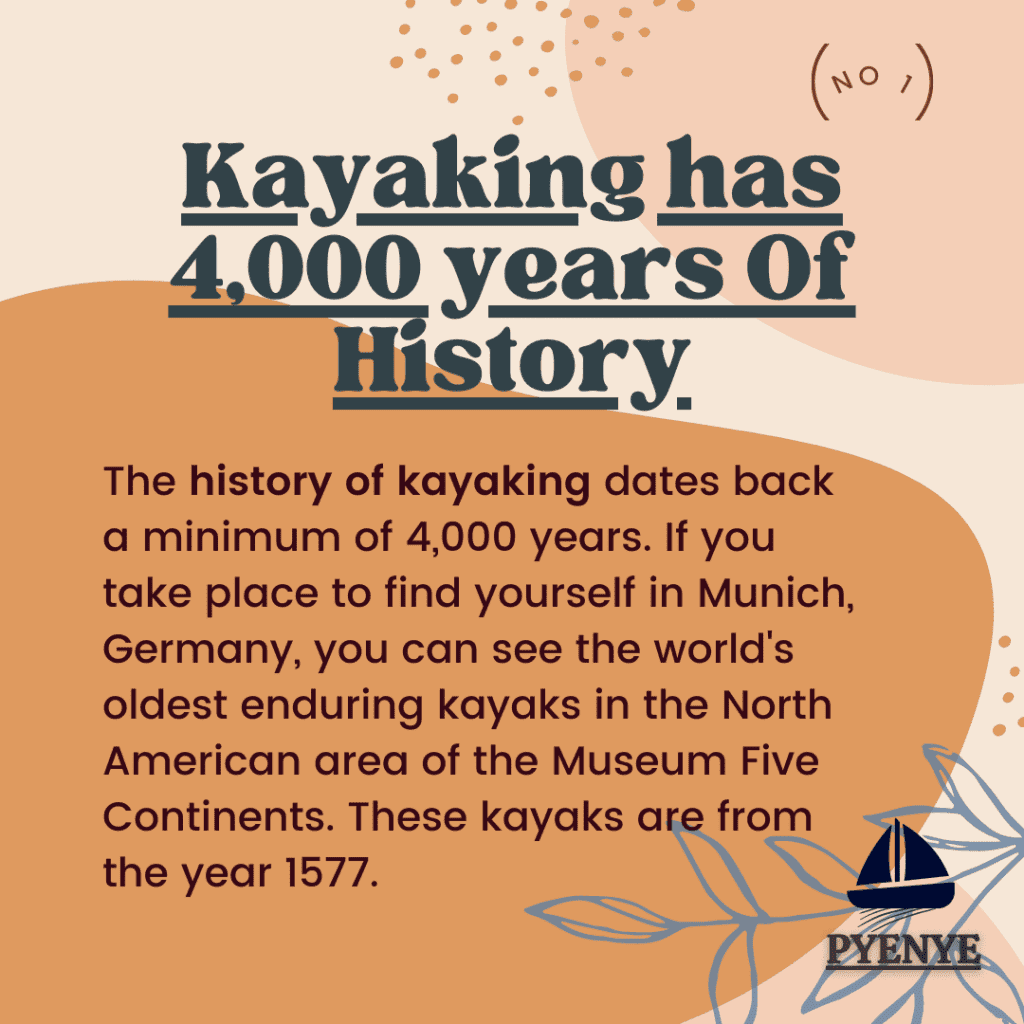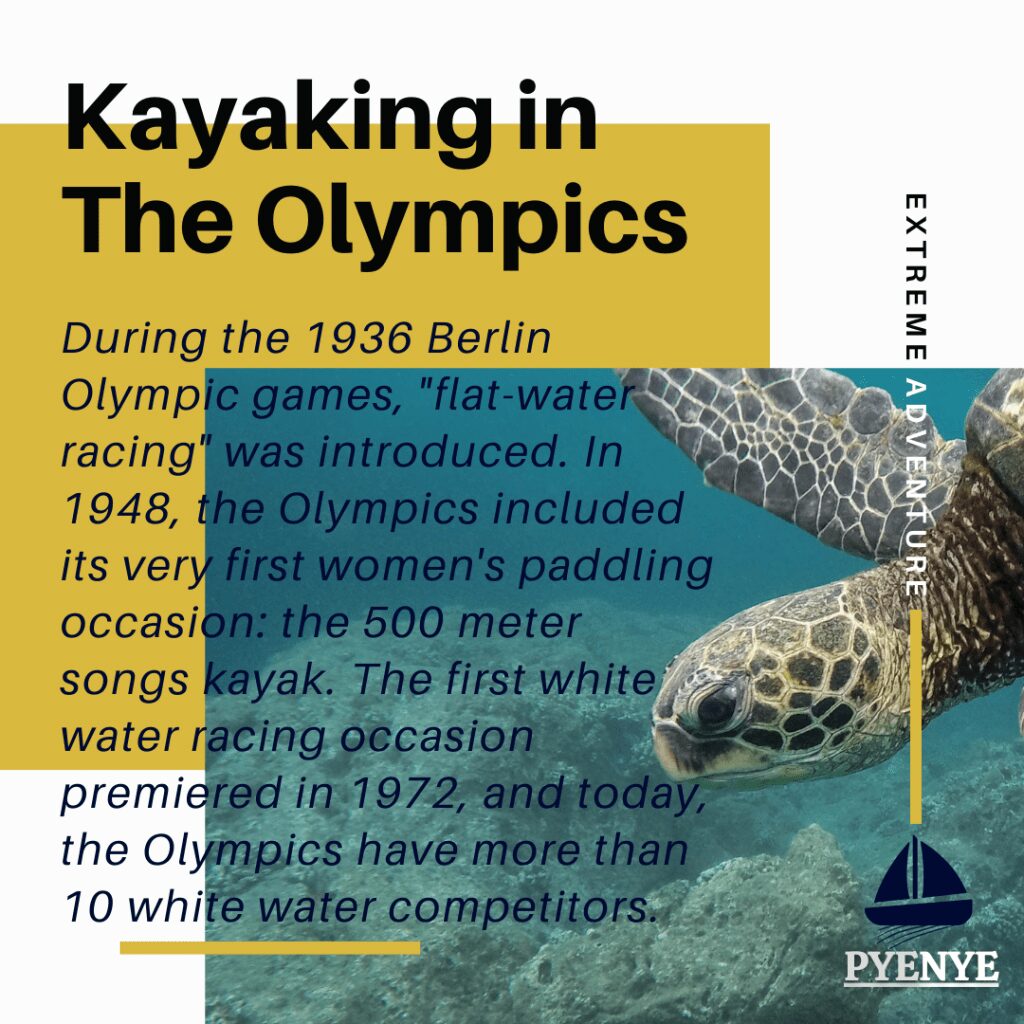Have you ever thought about roaming in a lake alone in the evening? Are you adventurous and like to explore the ocean? Do you have an interest in fishing? Have you ever become obsessed with racing in the water?
If it’s Yes, then kayak is the medium. The amazing history of kayaking will draw a line of adventure.
PyeNye Blog
It is a watercraft that is small and narrow. Mainly it is propelled by a double-bladed paddle. The traditional kayak has one or more cockpits for the paddler. Sometimes the cockpit covered by a spray deck which helps to roll the kayak.

Today people mainly use these watercraft for recreation and fun. Though in the history of kayaking, we found that the traditional people built and used kayaks for hunting and fishing. These small boats were helpful to creep up on animals that lived in the water or along the shore.
And the history of kayaking tells, kayaks were ideal for hunting and fishing. Because of their veiling nature as they help to catch unsuspecting animals on the shoreline or in the water.
We begin with the following question:
Kayaking has a big history. The watercraft was invented by the indigenous people of Alaska. Mainly the indigenous group named “Yup’ik”, and “Inuit” are credited for the invention. We have pointed out every fact of the history of kayaking in the guide.
It’s almost 4000 years history since kayaking has invented. The aboriginal communities of Alaska have invented watercraft.
In the history of kayaking, the word “kayak” has driven from the Greenlandic term named “Qajaq”.
Kayaks became popular in the 19th century. In the 19th century, kayaking started for sports, and recreational purposes and was used in military actions also.
Jump To A Section
History of Kayaking: Origin of The Word
The word kayak originates from the Greenlandic word “Qajaq“. In other words, it means ‘Hunter’s Boat’ or ‘Man’s Boat’. According to Merriam Webster, “Kayak is a light and definite craft that has to lessen ends to a point is drive by a double-wings paddle”.

The word was first used in 1757.
The literal meaning of kayak is “Small boat of skins”. And the word “KAYAK” drives from “QAJAQ”. Qajaq is a Greenlandic word.
And thereby the Aleut, Yup’ik people developed the watercraft. Aleut and Yup’ik are some of the groups of indigenous people living in Alaska.
Previously, kayaks were known as the “Hunter Boat”. Likewise, the main purpose was hunting and fishing. It was popular in indigenous Alaska communities.
“Qajaq” is a Greenlandic word. And the word “Kayak” comes from this ancient Greenlandic word.
Wikipedia
The History and Evolution of Kayaking
In the beginning, primitive people have used kayaks for fishing and hunting purposes. The indigenous people of Alaska introduced watercraft around 4000 years ago.
The watercraft is light in weight and narrow in shape. That’s why it moves easily. It moves by bladed paddle. But nowadays there are also motor kayaks which move faster and save energy. These kayaks are especially popular for long touring purposes and military activities.
But most importantly the evolutions of kayaking became serious in the 19th century. And from the beginning of the 19th-century kayaking more popular.
4000 Years History of Kayaking
To the common understanding, the kayak has a history of about 4000 years and archaeological evidence suggests 2000 years of this history of kayaking. On the other hand, according to oral tradition, the history of kayaking is much longer.
“Aleut” and “Inuit” are two indigenous communities of Arctic North America. They hold the credit for the invention of the kayak. And natural elements were very helpful for their invention. That is to say, by using natural elements like a skeleton and wooden frames, sealskin they have invented the kayak.
The user sat in the middle of the kayak. These watercraft were mainly used for hunting seals, caribou, and whales. The frames of some of the earliest kayaks were composed of bones of whales and wood. Animal skin was stretched around the frame. And the skins are also used for keeping the kayak waterproof.
The design of the early kayaks varied greatly from region to region. The kayak of the Bering Strait area was short and wide and it had a large storage capacity. It was stable and people could use it easily. The Aleuts designed kayaks that were long, fast, and seaworthy.
World’s oldest surviving kayak will be found in the North American section of the Museum Five Continents in Munich, Germany. But it was believed that this kayak had arrived in Holland in 1577.
World’s oldest kayak
The 31 facts of kayaking will be helpful for getting a complete view on the facts of kayaking history.
A Brief to 19th Century Kayaking History
In the 19th century, the people of the European world began to learn about early kayaks from the native people of Arctic North America and they started to develop their own designs.
Therefore, kayak, the hunting tool, became a medium of recreation. German and French society adopted this watercraft as a tool of sport and form of fitness. And thus the kayaking world started changing with rapid development.
Experiment with whitewater paddling
In 1931, for the first time in history, Adolf Anderle experimented with white water paddling in Salzachofen Gorge. After that, the International Scale of River Difficulty was established and modern whitewater kayaking took birth. Have a look at our river kayaking guidelines.
Fiberglass Rigid Kayaks
The manufacturing of kayaks has been changed over the years. At an early age, people used wood, bones, and animal skin to build kayaks. Europeans cover this with fabric and it continued before the 1950s when the fiberglass rigid kayaks were manufactured.
Gorge Dyson and Traditional Kayaks
Baidarkas mean the Aleutian kayak. In 1970, George Dyson came to Vancouver and he became interested in traditional construction methods for baidarkas.
During his life, he traveled and lived along coastal British Columbia and worked for a long time with traditional construction. The first plastic kayak was manufactured in 1984. And after that, it has become very light and strong. There are various kinds of kayaks in the industry.
Kayak History: Modern Kayaking
In modern days, the purpose of kayaking has differed from its history. Meanwhile, kayaks are now one of the sources of outdoor recreation, and thereby kayak history drives a new shore.
Now people love touring, surfing, fishing and lots with a kayak. Kayak is a popular sport now and in cases, it can accelerate military purposes.
Still, some of us are so afraid of kayaking. Thinking if it is hard to kayak, they remain aside from this adventurous pastime activity. Learning to kayak better from kayaking is not hard.
Recreational Kayaking
Recreational kayaking is a popular activity in the lakes. People mainly do it for fun and though it also has health benefits too. Recreational kayaks are quite wide and stable. And the paddler does not need any previous experience for recreational kayaking.
We can feel comfortable and enjoy nature by recreational kayaking.
Kayak Touring
Many people use kayaks for touring. They roam around protected areas of water. Especially, kayak touring depends on the paddler’s experience. Kayak touring becomes easier for experienced paddlers. Experienced means the paddlers who take kayaking seriously and can paddle for a long time with comfort.
The bow area of the kayak remains to unseal. And the paddlers should paddle on the protected bodies of the water.
Sea kayaking
Nowadays, people have a lot of interest in sea kayaking. Bay kayaking is challenging and unpredictable. Generally, sea kayaks have two sealed bulkheads. Basically, the challenging sea kayaking becomes easier by few practice the kayaking safety lessons.
Often the sea kayaks have a rudder. It helps to steer on the open water. And it can go in a sizeable wave. Heavy boats ate used in sea kayaking and they are generally 15 to 19 feet long. You need to practice in calm water if you want to kayak in the sea.
Kayak Surfing
Surfing mainly takes place in the oceans. But it does not use sea kayaks, rather surfers use white water kayaks. It is basically surfing with a kayak boat. We recommend taking the proper training before surfing and kayaking in the ocean. Because surfing is a quite different method of kayaking.
And sometimes it may seem dangerous for beginners. For such a kayaking experience, we need to maintain the kayaking safety regulations carefully.
Sit-on-top kayaking
Sit-on-top kayaking has become popular in recent years. Generally, in kayaking, the paddlers have to sit inside the kayak. But in sit-on-top kayaks, they have to sit on the boat. 20 percent of the paddlers are choosing sit-on-top kayaks.
History of Kayaking: Military And Kayaking
During the 2nd WorldWar, the kayak helped the military purposes. Especially the British military and special force used the watercraft under the special boat service. In addition, between 1939-1945 the lite-narrow watercraft was used rapidly for united operations.
Later in 1982, the United States Navy repeatedly use kayaks. They also used watercraft for several military actions.
Still, now kayaks are popular and helpful for military purposes. Nowadays, the special boat service uses a two-paddlers kayak.
Kayaking As A Sport
Anyone can paddle easily a kayak. Basically, people use sit-on-top kayaks for various purposes including recreation, fishing, and surfing. These kayaks are almost impossible to shrink in the water. If it flips on the water, the paddler just has to flip it back.
As a sport and competitive purpose, kayaking became popular in the 19th century. And the Olympic Games listed kayaking in almost the mid of the 19th century.
Besides, there are many kinds of kayaking including freestyle kayaking, extreme kayaking, slalom racing, river racing, and Olympic kayaking. For performing river kayaking, have a look at our cover on Hudson River kayaking.
Olympic History of Kayaking

The Berlin Summer Games (1936) has historical significance because of the rise of Hitler. But this event will also be memorable for introducing kayaks to Olympics. Before that Kayaking was a fringe sport and after this event, it became a mainstream sport.
The first known female who used the kayak in the Colorado and Green River was Genevieve De Colmont, The kayaking occurred in history in 1938.
First female kayak paddler in the history
History of Kayaking: The Activities
Throughout evolutions, kayaking has developed a lot. Now the purpose of kayaking is not only hunting and fishing. But today’s kayaking has been used for a lot of purposes. Therefore people around the world find kayaking as a medium of recreation, exercising, sporting, touring, and fishing.
For Health Benefits
Likewise, on the website of Better Health Channel, kayaking is good for cardiovascular health and it strengthens a number of major muscle groups throughout the body. That is why. it keeps the whole body active.
Moreover kayaking, we get medical advantages. kayaking improves heart well-being, controls cholesterol levels, expands perseverance, controls glucose, and lowers the pulse rate. In addition, kayaking is a good exercise. In this article, we’ve included everything physical and health benefits of kayaking.
Kayaking As a Sport
Kayaking is a good sport and it is popular around the world. However, kayaking has been included in the Olympics and there are many forms of competitive kayaking around the world. Therefore kayaking is introduced to different world games, the water sport becomes more popular.
Kayaking For Recreation
Yes! Moreover, kayaking is fun. Therefore it makes you fresh and healthy and it is a tool for exploring natural beauty. Above all, people manufacture special kayaks for recreational purposes.
Lastly, kayaking is one of the best water sports now. And paddling a kayak helps our body muscles, refreshes our mind, and it’s good for both particular enjoyment and group enjoyment.
Overall, we found the history of kayaks quite interesting. And the evolutions of kayaks have developed various types that suit different kayaking purposes.
In short, we tried to make the “History of kayaking” informative and helpful for you. Moreover, we would love it if you suggest something we missed.


